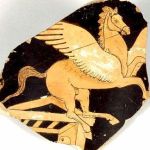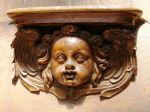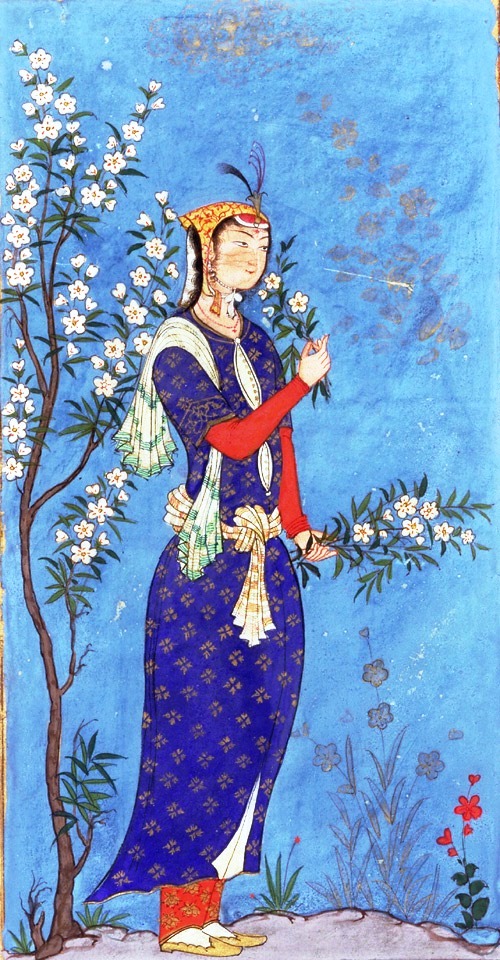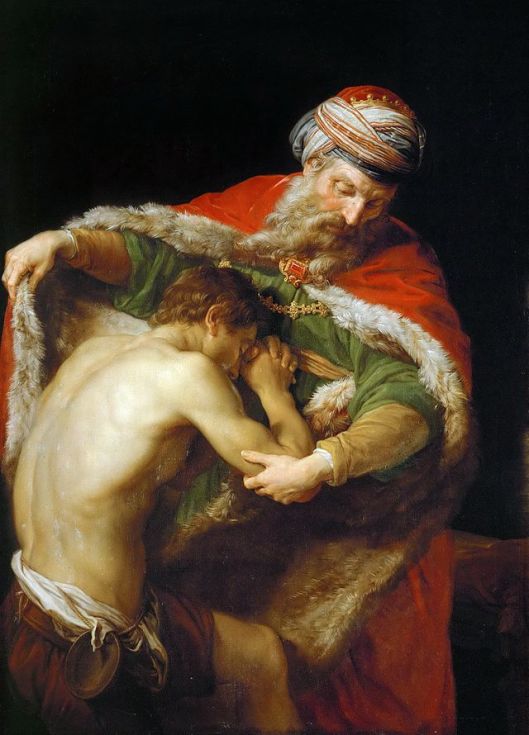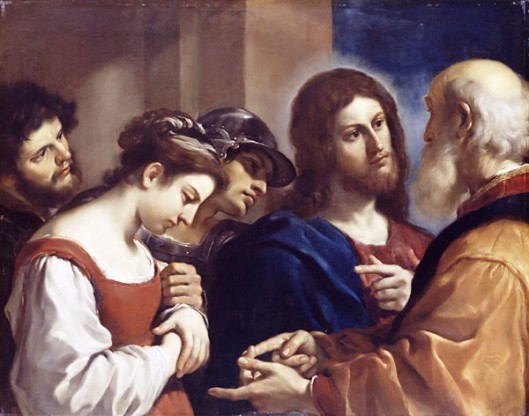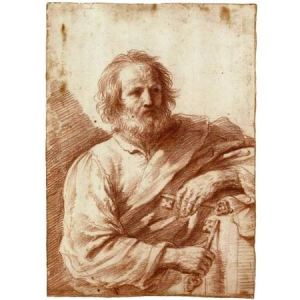Tags
Angels and Archangels, Dante, Guardian Angel, Healers, Hubris, Islam, John Milton, Messengers, Michael and Lucifer, Notre Seigneur en pauvre, Sir Ernest MacMillan, War in Heaven
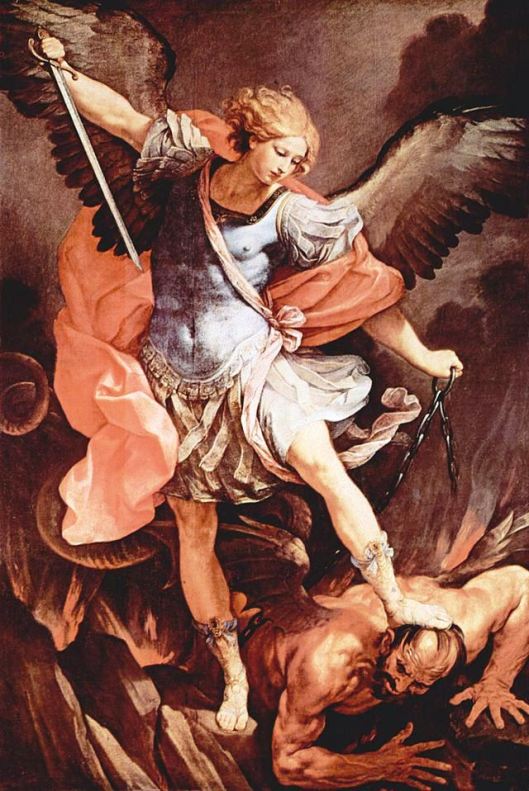
Archangel Michael wears a late Roman military cloak and cuirass in this 17th-century depiction by Guido Reni (Caption and Photo credit: Wikipedia)

Angel bearing Veronica’s Veil by Cosimo Fancelli at Ponte Sant’ Angelo (Photo credit: Wikipedia)
Angelology, the study of angels, is an extremely complex area of knowledge. Consequently, this post is a limited discussion. In fact, I will write a rather informal account of my findings, as though I were addressing students who have first been given the full written text.
First, angels are supernatural creatures and, therefore, immortal beings found in several religions and mythologies. In the beginning, they were members of a divine council and were referred to as “sons of God.” Later on, the term “sons of God” was applied to angels who engaged in sexual intercourse with women, mere mortals. (See Fallen angels, Wikipedia.) These angels could not return to heaven. They were “fallen angels” and, henceforth, mortals. But most angels have fallen led by Lucifer.
A War in Heaven
Michael Lucifer/Satan the DragonAccording to certain Muslim accounts,[1] Lucifer fell from grace because he would not bow to Adam, the first human being. In Greco-Roman mythology, hubris “extreme pride or self-confidence” leads to the demise of Icarus. (See Hubris, Wikipedia.)
“And there was war in heaven, Michael and his angels waging war with the dragon. The dragon and his angels waged war, and they were not strong enough, and there was no longer a place found for them in heaven… ” (The Apocalypse or Book of Revelation, 12.7)[2]
For most members of the Western Church, Lucifer fell from grace when, as the leader of rebellious angels, he was defeated by the archangel Michael, God’s “holy fighter.” There was a war in heaven, and Michael proved a stronger warrior than Lucifer. In Western Christianity, the archangel Michael is St Michael. His feast day, the former Michaelmas, is 29 September and it coincides with the fall equinox. In 2014, the fall equinox–equal daylight and darkness–occurred on 23 September.
The Islamic and Christian interpretations of Lucifer’s downfall do not contradict one another, which should be noted. One does not rebel against God. Lucifer, the defeated archangel became Satan, and he and his troops were sent to hell: inferno. Inferno is the title of the first book of Dante‘s (C. 1265 – 1321), Divine Comedy, Lucifer’s story parallels the fall of man and is also told in John Milton‘s (9 December 1608 – 8 November 1674) Paradise Lost.
These two books are monumental literary works and both have been illustrated by French engraver Gustave Doré (6 January 1832 – 23 January 1883) who portrayed Lucifer not as a dragon, evil incarnate, but as a human being with wings resembling those of a bat (la chauve-souris or, literally, the bald mouse).
In both Dante’s Divine Comedy and Milton’s Paradise Lost, the account of the fall of man is associated with that of the fall of angels. God told Adam and Eve not to eat at the Tree of Knowledge of Good and Evil and the archangel Raphael re-warned them. But they defied God’s directives, hubris, and thus lost their immortality. They were driven out of Paradise and Eve gave birth to Cain and Abel (evil and good).
Angels as Zoomorphic Creatures
In appearance, angels are zoomorphic, a blend of animal features or human and animal features. In the eyes of some early Christian Church fathers and lesser Christians, this was not altogether acceptable. Certain fathers of the Western Christian Church did not like the fact that angels had wings, an animal feature.
One reticent early saint was St. John Chrysostom (c. 349 – 407). How could nascent Christianity be burdened by so many winged creatures, all of whom were males? But the opposite could be just as embarrassing. How could a sacred text not shelter supernatural beings, despite their wings? Fortunately, it occurred to John Chrysostom that wings gave angels “sublimity.” Moreover, without wings, how could an angel be an intermediary between God and mere mortals? How could he be a prophet? (See Angel, Wikipedia.)
“Not that angels have wings, but that you may know that they leave the heights and the most elevated dwelling to approach human nature. Accordingly, the wings attributed to these powers have no other meaning than to indicate the sublimity of their nature.” (See Angel, Wikipedia.)At any rate, we do swear on the Bible despite the presence of angels. As for Satan,[3] the “shining one, morning star, Lucifer,” (see Strong’s Concordance [1822–1894], Wikipedia) he did lead rebellious angels. However, despite his fall from grace, Satan retained his name and, as Lucifer, the “morning star,” he remains the Christian counterpart to Roman mythology’s goddess Aurora, the goddess of dawn.

Gustave Doré, Depiction of Satan, the antagonist of John Milton‘s Paradise Lost, c. 1866 (Caption and Photo credit: Wikipedia)

Gustave Doré, illustration to Paradise Lost, book IX, 179–187: “… he [Satan] held on /His midnight search, where soonest he might finde /The Serpent: him fast sleeping soon he found…” (Caption and Photo credit: Wikipedia)
Origins
Historically, angels originate in Zoroastrianism, a monotheistic religion that arose in the ancient Persian Empire in the 6th century BCE. Zoroastrianism is named after the philosopher Zoroaster, also called Zarathustra, as in Friedrich Nietzsche’s Also sprach Zarathustra, set to music, a tone poem, by Richard Strauss.
Angels also originate in Abrahamic religions or Semitic religions: Judaism, Christianity, Islam, and the Bahá’í Faith. However, the notion of angels and demons is rooted in Zoroastrianism, a religion that postulates a constant struggle between good and evil. It resembles the Manichean heresy.
Angels and Archangels
Michael and Lucifer are archangels, a higher realm than angels. In Judaism, there were seven archangels. (See Archangels, Wikipedia.) The Eastern Christian Church also has a larger number of archangels than the Western Christian Church. But Catholicism has three archangels: Michael, God’s fighter, Gabriel, God’s messenger, and Raphael, “God who heals.” (See Raphael, Wikipedia.) A fourth archangel was Lucifer or Satan, a fallen angel.
Raphael would be an ancestor to Christianity’s “ministering angel” a female angel. There is a “ministering angel” in Shakespeare’s Hamlet (1598-1602): “a ministering angel shall my sister be[.]” The same words are used by Sir Walter Scott in Marmion (1808):[4]
When pain and anguish wring the brow, A ministering angel thou!Raphael would also be an ancestor to guardians angels. Angels have always been guides or counselors and this role has become their chief duty, a duty performed by a female.
As for Uriel, a post-Exilic Rabbinic angel, he could be the fourth Catholic archangel, but he belongs to other Christian traditions, not Catholicism.
Roles Angels Play
Michael is God’s fighter, Gabriel (Jibra’il or Jibril in Islam), God’s messenger, and Raphael, a healer. The archangel Gabriel announced to Mary that she was bearing Jesus. Gabriel therefore straddles Judaism and Christianity or the Old Testament and New Testament.
In Islam, angels are often made to carry messages from God to his prophets, one of whom is Muhammad, and another, Jesus. (See Prophets in Islam, Wikipedia.) Muhammad was also visited by Gabriel. (See Muhammad, Wikipedia.) But as messengers, angels and archangels have, at times, also been counsellors or guides. Had Adam and Eve listened, they would have retained their immortality.

Gardian Angel by Pietro da Cortona (Photo credit: Wikipedia)
Angels now
“Notre Seigneur en pauvre” (folklore) the “ministering angel” the “guardian angel”Angels have long been “ministering angels.” Their role as healers dates back to Raphael. Moreover, the following sentence points to godliness in the humblest among humans:
“Forget not to show love unto strangers: for thereby some have entertained angels unawares.” (Hebrews 13:2)
In French Canada, leaving a place at table for the beggar who might knock at the door was a tradition. One also left a bench at the door for the beggar (un gueux) to sleep on. The bench was a chest. I suppose there were blankets inside the chest. That beggar could have been Jesus himself.
Sir Ernest MacMillan set that legend to music, but very few people remember the story. Sir Ernest entitled his composition “Notre Seigneur en pauvre” (Our Lord as a poor man). I have inserted an untitled video at the foot of this post. It may be untitled, but that piece of music is Sir Ernest’s “Notre Seigneur en pauvre.”
Most importantly, however, angels are guardian angels. Guardian angels are sometimes portrayed looking after children who are about to cross a narrow bridge over a precipice or are standing near a precipice.

Schutzengel (Guardian Angel) by Bernhard Plockhorst depicts a guardian angel watching over two children (Photo credit: Wikipedia)
Conclusion
Where are seraphs and cherubs? Well, there simply was not enough room to include seraphs and cherubs in this post. Nor was there sufficient room to mention putti. These “angels” can be discussed at a later point. I was somewhat surprised to see that the entire Middle East harboured angels. The extent to which North Americans believe in angels is equally surprising. That figure, nearly 75%, is their true measure. The prominence of the fallen angel as an archetype is also astonishing.
Apologies and my kindest regards to all of you.
Sources and Resources
- The Divine Comedy is Gutenberg’s [eBook #8800]
- Paradise Lost is Gutenberg’s [eBook #26]
- The Fallen Angels
- Gustave Doré, The Divine Comedy illustrations
- Gustave Doré, Paradise Lost illustrations
_________________________
[2] In the Book of Revelation, also entitled the Apocalypse, the bad angel is a dragon, a mythical and zoomorphic being, but above all a symbol of evil. However, St. George slays a dragon.
[3] In Hebrew, Satan means adversary.
[4] Water Scott, Marmion (1808), quoted in Elizabeth Knowles, ed. “Ministering Angel,” The Oxford Dictionary of Phrase and Fable (Oxford: Oxford University Press, 2000).
The Alcan Quartet performs Sir Ernest MacMillan‘s “Notre Seigneur en pauvre”

Mosaic of St. Uriel by James Powell and Sons, at St John’s Church, Boreham, Wiltshire. (Photo credit: Wikipedia)








